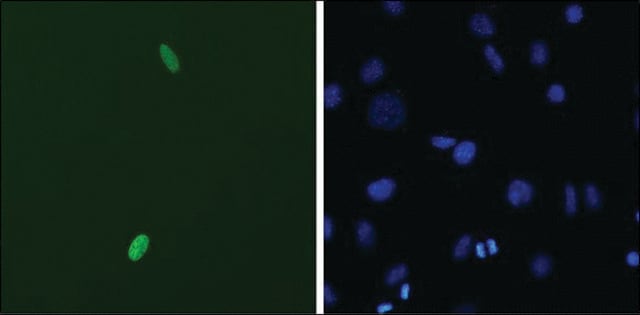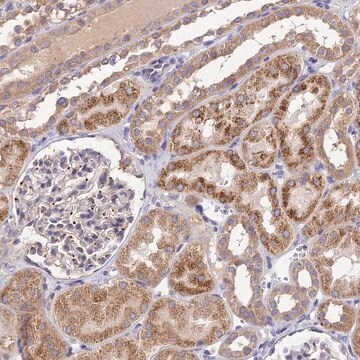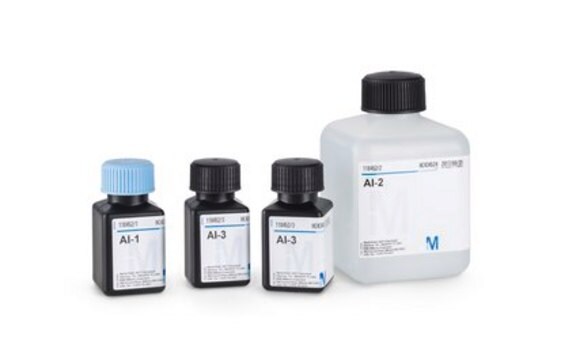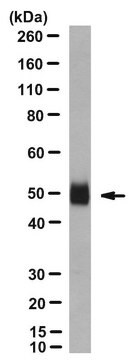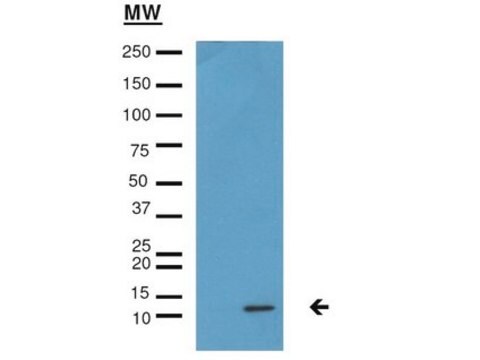MABS1348
Anti-DUX4 Antibody, clone P4H2
clone P4H2, from mouse
Synonym(e):
Double homeobox protein 4, Double homeobox protein 10
About This Item
Empfohlene Produkte
Biologische Quelle
mouse
Qualitätsniveau
Antikörperform
purified antibody
Antikörper-Produkttyp
primary antibodies
Klon
P4H2, monoclonal
Speziesreaktivität
human
Methode(n)
immunocytochemistry: suitable
western blot: suitable
Isotyp
IgG1κ
NCBI-Hinterlegungsnummer
UniProt-Hinterlegungsnummer
Versandbedingung
ambient
Posttranslationale Modifikation Target
unmodified
Angaben zum Gen
human ... DUX4(100288687)
Allgemeine Beschreibung
Spezifität
Immunogen
Anwendung
Zelluläre Signaltransduktion
Immunocytochemistry Analysis: A representative lot detected full-length DUX4 (DUX4-FL) nuclear immunoreactivity at a higher frequency among differentiated CD56+ myogenic cells from facioscapulohumeral dystrophy (FSHD) than non-FSHD individuals (Jones, T.I., et al. (2012). Hum. Mol. Genet. 21(20):4419-4430).
Immunocytochemistry Analysis: A representative lot detected exogenously expressed full-length human DUX4 (DUX4-FL) in 2% paraformaldehyde-fixed and 1% Triton X-100-permeabilized C2C12 mouse myoblasts (Geng, L.N., et al. (2011). Hybridoma (Larchmt). 30(2):125-130).
Immunocytochemistry Analysis: A representative lot and another DUX4 antibody that targets an N-terminal region epitope co-stained full-length DUX4 (DUX4-FL) in the nucleus in ~0.1% of cultured facioscapulohumeral dystrophy (FSHD) muscle cells fixed with 2% paraformaldehyde and permeabilized with 1% Triton X-100 (Snider, L., et al. (2010). PLoS Genet. 6(10):e1001181).
Western Blotting Analysis: A representative lot detected exogenously expressed human DUX4, but not DUX4c, in transfected C2C12 mouse myoblasts. No target band was detected in lysate from untransfected cells (Geng, L.N., et al. (2011). Hybridoma (Larchmt). 30(2):125-130).
Western Blotting Analysis: A representative lot detected DUX4 immunoprecipitated from human testis tissue lysate by another DUX4 antibody that targets an N-terminal region epitope (Snider, L., et al. (2010). PLoS Genet. 6(10):e1001181).
Qualität
Western Blotting Analysis: 0.5 µg/mL of this antibody detected DUX4 in 10 µg of human testis tissue lysate.
Zielbeschreibung
Physikalische Form
Lagerung und Haltbarkeit
Sonstige Hinweise
Haftungsausschluss
Sie haben nicht das passende Produkt gefunden?
Probieren Sie unser Produkt-Auswahlhilfe. aus.
Lagerklassenschlüssel
12 - Non Combustible Liquids
WGK
WGK 1
Flammpunkt (°F)
Not applicable
Flammpunkt (°C)
Not applicable
Analysenzertifikate (COA)
Suchen Sie nach Analysenzertifikate (COA), indem Sie die Lot-/Chargennummer des Produkts eingeben. Lot- und Chargennummern sind auf dem Produktetikett hinter den Wörtern ‘Lot’ oder ‘Batch’ (Lot oder Charge) zu finden.
Besitzen Sie dieses Produkt bereits?
In der Dokumentenbibliothek finden Sie die Dokumentation zu den Produkten, die Sie kürzlich erworben haben.
Unser Team von Wissenschaftlern verfügt über Erfahrung in allen Forschungsbereichen einschließlich Life Science, Materialwissenschaften, chemischer Synthese, Chromatographie, Analytik und vielen mehr..
Setzen Sie sich mit dem technischen Dienst in Verbindung.